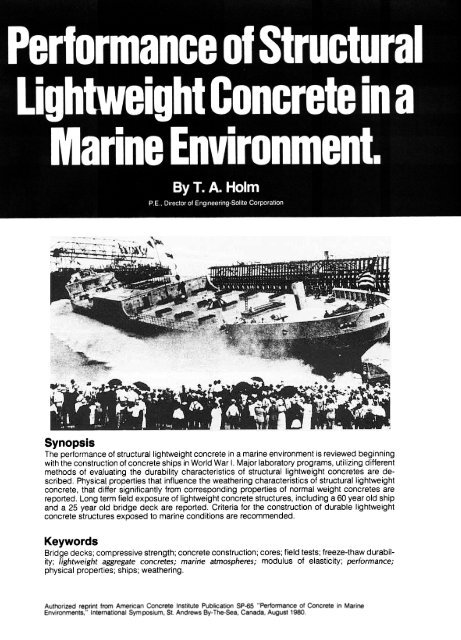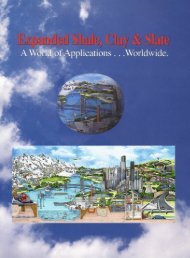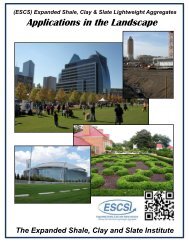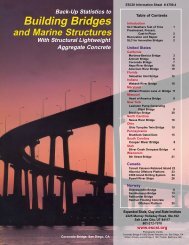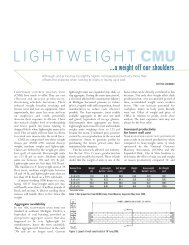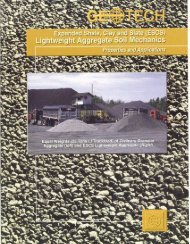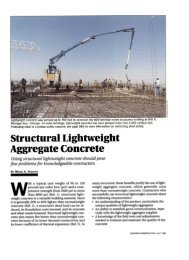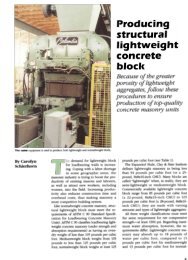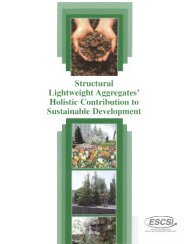I . . . . . Synopsis The performance of structural lightweight concrete in a
I . . . . . Synopsis The performance of structural lightweight concrete in a
I . . . . . Synopsis The performance of structural lightweight concrete in a
You also want an ePaper? Increase the reach of your titles
YUMPU automatically turns print PDFs into web optimized ePapers that Google loves.
I..~~ Irl ...1r;. ....rl<strong>Synopsis</strong><strong>The</strong> <strong>performance</strong> <strong>of</strong> <strong>structural</strong> <strong>lightweight</strong> <strong>concrete</strong> <strong>in</strong> a mar<strong>in</strong>e environment is reviewed beg<strong>in</strong>n<strong>in</strong>gwith the construction <strong>of</strong> <strong>concrete</strong> ships <strong>in</strong> World War I. Major laboratory programs, utiliz<strong>in</strong>g differentmethods <strong>of</strong> evaluat<strong>in</strong>g the durability characteristics <strong>of</strong> <strong>structural</strong> <strong>lightweight</strong> <strong>concrete</strong>s are described.Physical properties that <strong>in</strong>fluence the weather<strong>in</strong>g characteristics <strong>of</strong> <strong>structural</strong> <strong>lightweight</strong><strong>concrete</strong>, that differ significantly from correspond<strong>in</strong>g properties <strong>of</strong> normal weight <strong>concrete</strong>s arereported. Long term field exposure <strong>of</strong> <strong>lightweight</strong> <strong>concrete</strong> structures, <strong>in</strong>clud<strong>in</strong>g a 60 year old shipand a 25 year old bridge deck are reported. Criteria for the construction <strong>of</strong> durable <strong>lightweight</strong><strong>concrete</strong> structures exposed to mar<strong>in</strong>e conditions are recommended.KeywordsBridge decks; compressive strength; <strong>concrete</strong> construction; cores; field tests; freeze-thaw durability;<strong>lightweight</strong> aggregate <strong>concrete</strong>s; mar<strong>in</strong>e atmospheres; modulus <strong>of</strong> elasticity; <strong>performance</strong>;physical properties; ships; weather<strong>in</strong>g.Authorized repr<strong>in</strong>t from American Concrete Institute Publication SP-65 "Performance <strong>of</strong> Concrete <strong>in</strong> Mar<strong>in</strong>eEnvironments," International Sym posium, St. Andrews By- <strong>The</strong>-Sea, Canada, August 1980.
Figure # 1 -Generalview- -Dry cargo <strong>lightweight</strong> concrejship, World War IIFigure # 2-Lightweight <strong>concrete</strong> barge pass<strong>in</strong>gunder <strong>lightweight</strong> <strong>concrete</strong> bridge deck-World War II
Thomas A. Holm is an active member <strong>of</strong> ACI, and is a member<strong>of</strong> Committees 530,531 and213 <strong>of</strong> which he is past chairman.He is the Director <strong>of</strong> Eng<strong>in</strong>eer<strong>in</strong>g <strong>of</strong> Solite Corporation .<strong>The</strong> use <strong>of</strong> <strong>lightweight</strong> <strong>concrete</strong> <strong>in</strong> a mar<strong>in</strong>e environment ishardly a novel concept. Indeed, the orig<strong>in</strong> <strong>of</strong> the <strong>lightweight</strong>aggregate <strong>in</strong>dustry as we know it today is to a large degreedue to the collaboration <strong>in</strong> 1918 <strong>of</strong> American shipbuild<strong>in</strong>gauthorities with Stephen J. Hayde's development <strong>of</strong> astrong, <strong>in</strong>ert, durable, <strong>lightweight</strong> aggregate producedfrom a shale, clay or slate <strong>in</strong> a rotary kiln. Feasibility studiesby mar<strong>in</strong>e eng<strong>in</strong>eers at that time <strong>in</strong>dicated that a <strong>concrete</strong>ship would be practical if the <strong>concrete</strong> used could meet therequirements <strong>of</strong> strengths exceed<strong>in</strong>g 35 MPa (5 ksi) at adensity less than 1760 Kg/M3 (110 pcf) (1). Extensive<strong>in</strong>vestigations revealed that while naturally occurr<strong>in</strong>g <strong>lightweight</strong>aggregates could not meet these conditions, rotarykiln produced expanded shale could exceed the requirements.On a practical basis the first commercia) production<strong>of</strong> aggregate was conducted <strong>in</strong> a brick plant near Birm<strong>in</strong>gham,Alabama with enough aggregate produced to supply<strong>concrete</strong> for the 3000 ton Atlantus launched <strong>in</strong> December1918 (2). Aga<strong>in</strong> <strong>in</strong> 1941, with the advent <strong>of</strong> WorldWar II, immediate consideration was given to the use <strong>of</strong><strong>lightweight</strong> aggregate <strong>in</strong>stead <strong>of</strong> natural sand and gravelfor the <strong>concrete</strong>s to be used <strong>in</strong> the shipbuild<strong>in</strong>g program.<strong>The</strong> same type <strong>of</strong> <strong>lightweight</strong> aggregate successfully used<strong>in</strong> the World War I program was recommended for theconstruction <strong>of</strong> the second <strong>concrete</strong> fleet. Samples fromseveral commercial rotary kiln <strong>lightweight</strong> aggregate productionplants were sent to the laboratory <strong>of</strong> the PublicRoads Adm<strong>in</strong>istration for tests and, after comprehensive<strong>in</strong>vestigations, the rotary kiln <strong>lightweight</strong> aggregates proposedfor use were deemed satisfactory (3,4). In all, 104ships were constructed at five separate shipyards, withseveral different designs, with follow-up reports <strong>in</strong>dicat<strong>in</strong>gthe hulls to be watertight and hav<strong>in</strong>g good rid<strong>in</strong>g qualitieswith little vibration (Figures 1, 2, 3).After World War II there was a rapid development <strong>in</strong> theproduction capacity <strong>of</strong> the <strong>lightweight</strong> aggregate <strong>in</strong>dustry<strong>in</strong> North America, <strong>in</strong> order to meet the grow<strong>in</strong>g demands forthe use <strong>of</strong> <strong>lightweight</strong> <strong>concrete</strong> masonry units. <strong>The</strong>re wasalso the emerg<strong>in</strong>g use <strong>of</strong> <strong>structural</strong> <strong>lightweight</strong> <strong>concrete</strong> i~all forms <strong>of</strong> standard construction, pr<strong>in</strong>cipally <strong>in</strong> urbanareas for high rise <strong>concrete</strong> structures. At about the sametime <strong>lightweight</strong> <strong>concrete</strong> was <strong>in</strong>corporated <strong>in</strong>to precast/prestressed plants where the strength levels were considerab)yhigher than the requirements <strong>of</strong> cast-<strong>in</strong>-placestructures. This widespread construction use <strong>of</strong> rotary kilnproduced expanded shale <strong>concrete</strong>s was accompanied bymany technical papers, reports and <strong>in</strong>vestigations that aresummarized and digested <strong>in</strong> the "Guide for StructuralLightweight Aggregate Concrete" <strong>of</strong> the American ConcreteInstitute Committee 213 (5). At the present time,<strong>structural</strong> <strong>lightweight</strong> <strong>concrete</strong> <strong>in</strong> North America is notthought <strong>of</strong> as a fundamental departure from normal weight<strong>concrete</strong>, but merely a <strong>concrete</strong> with more efficient physicalproperties.It appears that a third major application <strong>of</strong> <strong>concrete</strong> <strong>in</strong>mar<strong>in</strong>e environments is presently underway, particularly <strong>in</strong>the development <strong>of</strong> ocean resources for our future energyrequirements. Mobile float<strong>in</strong>g platforms that could be towedto forward sites to provide operational or strategic functions,as well as massive permanent float<strong>in</strong>g structureshous<strong>in</strong>g ocean thermal-energy conversion systems couldbe effectively produced from <strong>structural</strong> <strong>lightweight</strong> aggregate<strong>concrete</strong>s <strong>of</strong> high specific strength (i.e. ratio <strong>of</strong>strength to density) (6, 7). In several seaboard locationsthere presently exists the production capacity <strong>of</strong> exist<strong>in</strong>g<strong>lightweight</strong> aggregate plants necessary to supply the hugedemands <strong>of</strong> such programs. In addition, the ability toproduce high quality, high strength-to-weight <strong>concrete</strong>s iscurrently available. Further improvement over the successfulpast experience <strong>of</strong> <strong>structural</strong> <strong>lightweight</strong> <strong>concrete</strong> isalso possible through the use <strong>of</strong> modern techniques <strong>in</strong>volv<strong>in</strong>gproportion<strong>in</strong>g <strong>concrete</strong> mixes with high-range waterreducers, the significant advantages <strong>of</strong> prestress<strong>in</strong>g andpost tension<strong>in</strong>g as well as sophisticated <strong>structural</strong> designtechniques.This report will deal only with the durability <strong>performance</strong><strong>of</strong> <strong>concrete</strong>s produced with <strong>structural</strong> <strong>lightweight</strong> aggregatesas well as several significant physical propertydifferences from regular weight <strong>concrete</strong>s that have adirect, phenomenological relationship to resistance toweather<strong>in</strong>g. For physical properties and related aspectsthat are common to all <strong>concrete</strong>s <strong>in</strong> a mar<strong>in</strong>e environment(admixtures, cement type and chemistry, compactiontechniques, steel re<strong>in</strong>forcement, embedded items, etc.) thereader is referred to the comprehensive presentationsprovided by Gerwick (8,9).Figure # 3-Construction <strong>of</strong> <strong>lightweight</strong> <strong>concrete</strong> ship-World War II
<strong>The</strong> first major <strong>in</strong>dustry-wide laboratory <strong>in</strong>vestigation <strong>in</strong>tothe freeze-thaw resistance <strong>of</strong> <strong>structural</strong> <strong>lightweight</strong> <strong>concrete</strong>swas conducted by Klieger and Hanson (10) at thePortland Cement Association Laboratory. Concretes fncorporat<strong>in</strong>gn<strong>in</strong>e <strong>lightweight</strong> aggregates manufactured byseveral different processes were tested with the primaryvariable be<strong>in</strong>g strength level, 20 and 31 MPa (3 and 4.5 ksi)with and without air-entra<strong>in</strong>ment. Results were comparedwith tests on a reference normal weight <strong>concrete</strong> with agood service record <strong>in</strong> field <strong>performance</strong>. After a moistcur<strong>in</strong>g period <strong>of</strong> 14 days, at 23°C (73°F), 100% RH, followedby dry<strong>in</strong>g <strong>in</strong> lab air for 14 days at 23°C (73°F), 50% RH, andthen a 3 day immersion <strong>in</strong> water, <strong>concrete</strong> prisms weresubjected to rapid freeze-thaw <strong>in</strong> water (formerly ASTMC-290, presently ASTM C-666 Method A). Severe laboratoryconditions were imposed on some <strong>of</strong> the specimens:low cement contents, non-air-entra<strong>in</strong>ment, short dry<strong>in</strong>gperiod, freeze-thaw cont<strong>in</strong>uously under water at an earlyage, and repetitive extreme moisture gradients that areunrepresentative <strong>of</strong> the weather<strong>in</strong>g <strong>of</strong> actual structures. Itwas not surpris<strong>in</strong>g to have the authors conclude, "thespread <strong>in</strong> durability among the <strong>concrete</strong>s made with thedifferent <strong>lightweight</strong> aggregates appears no greater thanmight be encountered with normal weight aggregates".High durability (small weight loss, <strong>in</strong>significant expansionsand almost no decrease <strong>in</strong> sonic modulus) was demonstratedafter 300 cycles <strong>of</strong> freez<strong>in</strong>g and thaw<strong>in</strong>g by theproperly proportioned, air-entra<strong>in</strong>ed <strong>lightweight</strong> aggregate<strong>concrete</strong>s. Expand<strong>in</strong>g on the extensive date provided <strong>in</strong> thefirst PCA series, Pfeifer (11) cont<strong>in</strong>ued with durabilitystudies <strong>of</strong> <strong>structural</strong> <strong>lightweight</strong> <strong>concrete</strong>s and <strong>in</strong>cluded astudy <strong>of</strong> the <strong>in</strong>fluence <strong>of</strong> replacement <strong>of</strong> a part <strong>of</strong> all <strong>of</strong> the<strong>lightweight</strong> f<strong>in</strong>e aggregate fraction with natural sand.In an attempt to correlate the good field durability experience<strong>of</strong> <strong>structural</strong> <strong>lightweight</strong> <strong>concrete</strong>s <strong>in</strong> a number <strong>of</strong>North American projects, the Expanded Shale Clay andSlate Institute sponsored three comprehensive series <strong>of</strong>freeze-thaw tests at the University <strong>of</strong> Toledo (12). In the firstseries eight rotary kiln produced <strong>lightweight</strong> aggregatesand one reference normal weight aggregate were testedwith the ma<strong>in</strong> variables be<strong>in</strong>g sand replacement <strong>of</strong> f<strong>in</strong>eaggregate and moisture content <strong>of</strong> the <strong>lightweight</strong> aggregateat time <strong>of</strong> mix<strong>in</strong>g. Rapid freeze-thaw <strong>in</strong> water procedureswere repeated. However, <strong>concrete</strong>s were proportioned<strong>in</strong> accordance with usual field practice (aircontents at 6% and 1 %, 100 mm (4") slump and cementcontents for all mixes at 360 Kg/M3 (611 pcy). This programdemonstrated that <strong>structural</strong> <strong>concrete</strong>s with high qualitymortar fractions and conta<strong>in</strong><strong>in</strong>g rotary' kiln produced <strong>lightweight</strong>aggregates performed satisfactorily for at least 300cycles <strong>of</strong> freez<strong>in</strong>g and thaw<strong>in</strong>g <strong>in</strong> water, both with or withoutsand replacement. Compar<strong>in</strong>g dry<strong>in</strong>g times <strong>of</strong> 14, 28 and56 days, the results obta<strong>in</strong>ed on the 32 <strong>concrete</strong> mixestested showed little variation, <strong>in</strong>dicat<strong>in</strong>g that a dry<strong>in</strong>g period<strong>of</strong> 14 days prior to the first freeze-thaw cycle was sufficientfor <strong>concrete</strong>s mixed with aggregates at usual field moisturecontents.<strong>The</strong> results <strong>of</strong> these major programs that <strong>in</strong>clude hundreds<strong>of</strong> laboratory tests may be simplistically summarizedby not<strong>in</strong>g that air-entra<strong>in</strong>ed <strong>lightweight</strong> <strong>concrete</strong>s proportionedwith a high quality b<strong>in</strong>der provide satisfactorydurability results when tested under usual laboratoryfreeze-thaw programs.Additionally, freeze-thaw test programs were conductedfor analysis by the technical committees <strong>of</strong> various eng<strong>in</strong>eer<strong>in</strong>gsocieties. One series <strong>of</strong> tests (13) <strong>in</strong>cluded comparisons<strong>of</strong> test<strong>in</strong>g environments, (freez<strong>in</strong>g <strong>in</strong> air or water)as well as attempts to correlate freeze-thaw laboratory<strong>concrete</strong> tests with more convenient and rapid aggregatesoundness tests us<strong>in</strong>g cycles <strong>of</strong> wett<strong>in</strong>g and dry<strong>in</strong>g <strong>in</strong> saltsolutions. <strong>The</strong>se tests <strong>in</strong>dicated that, <strong>in</strong> general, low soundnesslosses on aggregates correlated with good freezethawlaboratory <strong>performance</strong> <strong>of</strong> properly proportioned<strong>concrete</strong> made from the tested aggregates. Suggestedsoundness and freeze-thaw criteria from these tests were<strong>in</strong>corporated <strong>in</strong>to the material specifications <strong>of</strong> some governmentorganizations.Each particular <strong>lightweight</strong> aggregate has a limit<strong>in</strong>gstrength "ceil<strong>in</strong>g" beyond which there can be no appreciablestrength ga<strong>in</strong> despite large <strong>in</strong>creases <strong>in</strong> cementitiousmaterials. This strength "ceil<strong>in</strong>g" is a function <strong>of</strong> thestrength <strong>of</strong> the vitreous material and the quantity, size,shape and distribution <strong>of</strong> the enveloped pores, but thedecisive factor is the strength <strong>of</strong> the largest <strong>in</strong>dividualparticle. In one high strength <strong>lightweight</strong> <strong>concrete</strong> <strong>in</strong>vestigation(14), 10 mm (%") coarse aggregate top size consistentlyproduced strengths equal to or greater than normalweight <strong>concrete</strong>s with equal b<strong>in</strong>der content. One series <strong>of</strong>results is shown <strong>in</strong> Figure 4. Long term strength ga<strong>in</strong> <strong>of</strong> the<strong>structural</strong> <strong>lightweight</strong> <strong>concrete</strong> is generally greater than thecompanion normal weight <strong>concrete</strong>s, due to the cont<strong>in</strong>uoushydration <strong>of</strong> the b<strong>in</strong>der with the moisture available from theslowly released reservoir <strong>of</strong> water absorbed with<strong>in</strong> thepores <strong>of</strong> the <strong>lightweight</strong> aggregate. This process <strong>of</strong> "<strong>in</strong>ternalcur<strong>in</strong>g" is possible when the moisture content <strong>of</strong> the <strong>lightweight</strong>aggregate at the time <strong>of</strong> mix<strong>in</strong>g is at least equal tothat achieved by soak<strong>in</strong>g for one day. <strong>The</strong> effect <strong>of</strong> "<strong>in</strong>ternalcur<strong>in</strong>g" is further enhanced if a pozzolan (fly ash or suitable<strong>lightweight</strong> aggregate f<strong>in</strong>e fraction) is <strong>in</strong>troduced <strong>in</strong>to themix. It is well known that the pozzolanic reaction <strong>of</strong> a f<strong>in</strong>elydivided alum<strong>in</strong>o-silicate material with calcium hydroxideliberated as cement hydrates is cont<strong>in</strong>gent upon theavailability <strong>of</strong> moisture. It should be po<strong>in</strong>ted out that thepozzolanic activity <strong>of</strong> some <strong>lightweight</strong> f<strong>in</strong>e aggregates is adependable. consistent property that is fully exploited as acement replacement <strong>in</strong> the high temperature cur<strong>in</strong>g <strong>of</strong><strong>concrete</strong> masonry units. In this application however, thepozzolanic behavior should be considered as a desirable,additional virtue, and not for cement reduction.
eo1."..{;;;0:7'""",~P--10910 mm SOLITEI , I---j--- 106 10 mm SOLITE-1110lUQ.~:I:1-"ZW11:1-00W>Ci500w11:Q.~O()6030120,,1,,' I-' 9~-11020 mm SOLITE (FiYASh)I--.L--~---1. 11115mmSTONE(AyAsh) 1~.:'~-~~--t-- o 107 20 mm SOLITE ,---8-10815 mm STONEIIL- 57643!~~w~w>~wa:0.~our--'f--21050 100 150 200AGE AT TEST-DAYSFigure # 4-Compressive strength versus age <strong>of</strong> <strong>lightweight</strong> and normal weight<strong>concrete</strong> (1975-1979 series)
It is curious that <strong>in</strong> the material recommendations <strong>of</strong> theFederation Internationale de la Precontra<strong>in</strong>te (15) for thedesign and construction <strong>of</strong> <strong>concrete</strong> sea structures, there isa suggestion for the addition <strong>of</strong> pozzolanic material forord<strong>in</strong>ary Portland cements hav<strong>in</strong>g a C3A content greaterthan 8% , while <strong>in</strong> the aggregate section there is a recommendationaga<strong>in</strong>st the use <strong>of</strong> f<strong>in</strong>e aggregates which mayreact with the cement. Somewhere, with<strong>in</strong> the cont<strong>in</strong>uum <strong>of</strong>gradation, f<strong>in</strong>e <strong>lightweight</strong> aggregate with the properphysical and chemical characteristics may transcend thisarbitrary division <strong>of</strong> m<strong>in</strong>eral constitl)ents and simultaneouslyprovide roles <strong>of</strong> aggregate as well as cementitiousb<strong>in</strong>der. <strong>The</strong> U.S.S. Selma, a 7500 ton re<strong>in</strong>forced expanded shale<strong>concrete</strong> tanker launched <strong>in</strong> 1919 is perhaps the most vividtestament to the durability <strong>in</strong> a mar<strong>in</strong>e environment <strong>of</strong><strong>structural</strong> <strong>lightweight</strong> <strong>concrete</strong>. After several years <strong>of</strong> servicethis vessel was purposely sunk <strong>in</strong> 1922 <strong>in</strong> GalvestonBay, Texas where it has rema<strong>in</strong>ed partially submerged evers<strong>in</strong>ce. <strong>The</strong> hull has been <strong>in</strong> sea water for over 60 years with aband width <strong>of</strong> approximately 1 meter exposed to wett<strong>in</strong>gand dry<strong>in</strong>g <strong>in</strong> salt air caused by w<strong>in</strong>d and tides. <strong>The</strong> deckOne explanation for the excellent durability service record<strong>of</strong> high strength <strong>lightweight</strong> <strong>concrete</strong> may lie <strong>in</strong> the similarity<strong>of</strong> the strength and stiffness characteristics <strong>of</strong> the coarse<strong>lightweight</strong> aggregate and the rema<strong>in</strong><strong>in</strong>g "mortar" fraction.It has been reported (14) that the stress-stra<strong>in</strong> curves <strong>of</strong>high strength <strong>lightweight</strong> <strong>concrete</strong> are l<strong>in</strong>ear to levelsapproach<strong>in</strong>g 90% <strong>of</strong> the failure strength, (Figure 5) <strong>in</strong>dicat<strong>in</strong>gthe relative compatibility <strong>of</strong> the elastic and strengthcharacteristics <strong>of</strong> the coarse <strong>lightweight</strong> aggregate and themortar component (cement paste and natural sand), thatsurrounds the large aggregate. "Elastic Match<strong>in</strong>g" <strong>of</strong> thetwo components, produc<strong>in</strong>g relatively "homogeneous"<strong>concrete</strong>, will be possible if the coarse aggregate partic)eshave sufficient particle strength to match the strengthcharacteristics <strong>of</strong> the mortar fraction. This separation <strong>of</strong> thestrength and elastic properties <strong>of</strong> the two components <strong>of</strong> aheterogenous <strong>concrete</strong> system has been thoroughlystudied by others (16, 17), but generally, <strong>in</strong> relation to a"stiff" aggregate <strong>in</strong> a "s<strong>of</strong>t" mortar (high strength normalweight <strong>concrete</strong>s), where EM < Ec < EA, <strong>concrete</strong>s fail dueto bond limitations or microcrack<strong>in</strong>g <strong>in</strong>itiated by an extremelyrigid coarse aggregate; or a "s<strong>of</strong>t" aggregate <strong>in</strong> a"stiff" mortar (low density <strong>in</strong>sulat<strong>in</strong>g <strong>lightweight</strong> aggregate<strong>concrete</strong>s), EM > Ec > EA, where failure is due to crush<strong>in</strong>g <strong>of</strong>the very light, <strong>lightweight</strong> aggre.gate particles. A thirdsituation may exist where<strong>in</strong> the coarse aggregate particlestrength and elastic characteristics closely match and aresecurely bonded to a high quality mortar fraction (EM ~ Ec ~EA). Analysis <strong>of</strong> this mechanism is currently underway andwill be reported at a later date. "Russian studies, approach<strong>in</strong>g <strong>concrete</strong> durability from aphenomenological aspect, have also noted the high <strong>in</strong>nerstress conditions due to different deformation responses <strong>of</strong>the various cj)nstituents, ". ..as elasticity modulus decreases...thestresseS'ln the conglomerate fall<strong>of</strong>f, it leads...to the <strong>in</strong>crease <strong>in</strong> frost resistance. And really, <strong>concrete</strong>with keramzite (<strong>lightweight</strong>) gravel and' sand, the elasticitymodulus <strong>of</strong> which is much less than that <strong>of</strong> volcanic solidrocks possess <strong>of</strong>ten greater frost resistance than, forexample, <strong>concrete</strong> made with granitic crushed stone" (18).and upper section <strong>of</strong> the hull have been exposed to salt airand occasionally awash with sea water due to wave action<strong>in</strong> storms (Figure 6).A study <strong>of</strong> the <strong>concrete</strong> was sponsored by <strong>The</strong> ExpandedShale Clay and Slate Institute <strong>in</strong> 1953 and reported <strong>in</strong> thepublication, "Story <strong>of</strong> the Selma-Expanded Shale ConcreteExplores the Ravages <strong>of</strong> Time" (1 ). This study reportedthat cubes and cores taken from the waterl<strong>in</strong>e areahad compressive strengths <strong>of</strong> approximately 55 to 75 MPa(8 to 11 ksi) when normalized to 150 x 300 mm (6" x 12")cyl<strong>in</strong>ders. Modulus <strong>of</strong> elasticity was reported at 20 x 103MPa (3 x 106 psi) and a bond strength on pla<strong>in</strong> re<strong>in</strong>forc<strong>in</strong>gbars <strong>of</strong> 3.56 MPa (516 psi). Surpris<strong>in</strong>gly little corrosion wasnoted despite a coverage <strong>of</strong> only 16 mm (5/8"} (Figure 7).In 1980 the Selma's <strong>performance</strong> was reviewed aga<strong>in</strong>with cores taken for an up-date on the extensive testsconducted <strong>in</strong> 1953. Exam<strong>in</strong>ation <strong>of</strong> both the submergedand waterl<strong>in</strong>e area cores <strong>of</strong> the sixty year old <strong>lightweight</strong><strong>concrete</strong> revealed little if any deterioration (Figure 8). Formmarks on the core's exterior surface were visible and noevidence <strong>of</strong> microcrack<strong>in</strong>g was observed when viewedunder a magnify<strong>in</strong>g glass. <strong>The</strong> <strong>concrete</strong> was extremely wellcompacted (the first known application <strong>of</strong> <strong>in</strong>ternal vibrationtechniques) with only a small number <strong>of</strong> macroscopjc airvoids, coarse aggregate (m<strong>in</strong>us V2") was well bonded to themortar fraction, uniformly distributed and without any <strong>in</strong>dication<strong>of</strong> water ga<strong>in</strong> under large aggregate particles <strong>in</strong>dicat<strong>in</strong>ga fluid easily pJaced, but not wet <strong>concrete</strong>. (Aneng<strong>in</strong>eer <strong>in</strong> charge <strong>of</strong> the Emergency Fleet Corporation <strong>in</strong>1919 developed an apparatus to control the workability <strong>of</strong>the <strong>concrete</strong> from batch to batch and provided the <strong>in</strong>dustrywith the <strong>in</strong>itial slump cone test). Particle shape <strong>of</strong> theaggregate was semi-angular to rounded, typical <strong>of</strong> modern<strong>lightweight</strong> aggregates. Visible pore structure <strong>of</strong> the <strong>lightweight</strong>aggregate was f<strong>in</strong>e to medium.Core samples cut through the undeformed steel re<strong>in</strong>forc<strong>in</strong>gbars showed little evidence <strong>of</strong> rust<strong>in</strong>g. <strong>The</strong>re wasalmost no sign <strong>of</strong> corrosion at the re<strong>in</strong>forc<strong>in</strong>g bar to <strong>concrete</strong><strong>in</strong>terface that could be observed when cut sections <strong>of</strong>steel were <strong>in</strong>advertently separated from broken cores.Compression strength measured on the <strong>concrete</strong> cores,normalized to 150 x 300 mm (6" x 12") cyl<strong>in</strong>ders was 70MPa (10.2 ksi); the modulus <strong>of</strong> elasticity <strong>in</strong> compressionwas 25 x 103 MPa (3.59 x 106 psi). <strong>The</strong>se values arecomparable to the results <strong>of</strong> the cores and cubes test
esults from the 1953 <strong>in</strong>vestigation. In addition, the result <strong>of</strong>the Selma <strong>concrete</strong> stress-stra<strong>in</strong> curve is superimposed <strong>in</strong>Figure 5 on the results <strong>of</strong> recent(y completed high strength<strong>lightweight</strong> <strong>concrete</strong> test program (14). <strong>The</strong> similarity <strong>of</strong> thedata on the <strong>concrete</strong> specimens, cast almost 60 yearsapart, is evident.Explanations <strong>of</strong> this unusual resistance to weather<strong>in</strong>gand corrosion is difficult to quantify and may <strong>in</strong>clude someor all <strong>of</strong> the follow<strong>in</strong>g physical and chemical mechanisms:1. Superior resistance to microcrack<strong>in</strong>g due to high bond<strong>of</strong> aggregate to mortar fraction comb<strong>in</strong>ed with thereduction <strong>of</strong> <strong>in</strong>ner stresses due to elastic match<strong>in</strong>g <strong>of</strong> thecoarse aggregate and the mortar phase.2. High ultimate stra<strong>in</strong> capacity provided by a <strong>concrete</strong>with a high strength to modulus ratio.3. A well dispersed void system provided by the f<strong>in</strong>e<strong>lightweight</strong> aggregate fraction that may serve an absorptionfunction <strong>in</strong> weather<strong>in</strong>g resistance as well asreduc<strong>in</strong>g salt concentration levels <strong>in</strong> the mortar phase.4. Long term pozzolanic action provided by <strong>lightweight</strong>f<strong>in</strong>e aggregate with the proper physical and chemicalcharacteristics that could comb<strong>in</strong>e with the calciumhydroxide liberated dur<strong>in</strong>g cement hydration. This couldm<strong>in</strong>imize the leach<strong>in</strong>g <strong>of</strong> soluble compounds and <strong>in</strong>addition may reduce the possibility <strong>of</strong> sulphate saltdisruptive behavior.5. Low mortar permeability provided by the comb<strong>in</strong>ation <strong>of</strong>high cement contents and the water available <strong>in</strong> the<strong>lightweight</strong> aggregate for <strong>in</strong>ternal cur<strong>in</strong>g.Attempts to evaluate the potentially beneficial contribution<strong>of</strong> these mechanisms will cont<strong>in</strong>ue <strong>in</strong> the future.MODULUS OF ELASTICITY (SECANT MODULUS) OF "SELMA" CONCRETEFIRST TEST LOADED TO 3950 P.S.I. -E = 3, 100,000 P.S.I. -SOLIDSECOND TEST LOADED TO 5930 P.S.I. -E = 3,000,000 P.S.I. -DASHED--.2QQQj~...1QQQuju..-~',#0.'~"""7'"".,.,.;0-13000U)-U)I~~./J".w.£QQQ1000Q.0002 00040006 .0008 .0010 .0012 .0014 .0016DEFORMATION-STRAININ. PER INCH0018Od20Adrian PauwU. <strong>of</strong> Missouri9/23/53Figure # 8-Stress-stra<strong>in</strong> curve <strong>of</strong> U.S.S. Selma <strong>lightweight</strong> <strong>concrete</strong> from 1953 tests
:igure # 9. -Chesapeake Bay Bridge- ~nnapolis, Maryland, constructed 1954Many <strong>lightweight</strong> <strong>concrete</strong> bridge decks have been constructed<strong>in</strong> mar<strong>in</strong>e environments throughout North America,<strong>in</strong>clud<strong>in</strong>g major projects such as the 7 km (4.5 miles)Chesapeake Bay Bridge, constructed <strong>in</strong> 1954 at Annapolis,Maryland with a design strength <strong>of</strong> 24 MPa (3.5 ksi) and anair dry density <strong>of</strong> 1680 Kg/Mg3 (105 pcf) (Figure 9). Aftercompletion <strong>in</strong> 1975 <strong>of</strong> a second parallel cross<strong>in</strong>g to handlethe <strong>in</strong>creased traffic load, the asphalt wear<strong>in</strong>g surface <strong>of</strong>the orig<strong>in</strong>al bridge was removed and an extensive <strong>in</strong>vestigation<strong>in</strong>to the serviceability <strong>of</strong> the <strong>concrete</strong> deck conductedby an <strong>in</strong>dependent test<strong>in</strong>g laboratory (19). Freez<strong>in</strong>g andthaw<strong>in</strong>g comb<strong>in</strong>ed with rapid temperature cycl<strong>in</strong>g, roadsalt exposure, vibration and stress reversals typical <strong>of</strong> longspan bridges may constitute an environment that is moresevere than cont<strong>in</strong>uous immersion. Extensive physical tests(core drill<strong>in</strong>g, petrographic and ultrasonic) revealedexcellent condition <strong>of</strong> the non-air-entra<strong>in</strong>ed <strong>lightweight</strong><strong>concrete</strong> <strong>of</strong> the ma<strong>in</strong> spans. Deterioration <strong>of</strong> the non-airentra<strong>in</strong>ednormal weight <strong>concrete</strong> <strong>of</strong> the approach spansrequired a significant amount <strong>of</strong> <strong>concrete</strong> removal andrepair. After the <strong>in</strong>vestigation demonstrated that repair <strong>of</strong>the <strong>lightweight</strong> <strong>concrete</strong> spans was not necessary, a newwear<strong>in</strong>g surface was applied and the bridge put back <strong>in</strong>toservice.It is especially <strong>in</strong>terest<strong>in</strong>g that Fagerlund's extraord<strong>in</strong>arilycomprehensive theoretical and laboratory <strong>in</strong>vestigations<strong>in</strong>to the "Frost Resistance <strong>of</strong> Concretes with Porous Aggregates"(20) suggested extra frost resistance could beavailable <strong>in</strong> some <strong>lightweight</strong> <strong>concrete</strong>s <strong>in</strong> that, "<strong>The</strong> reasonfor this feature could be that <strong>lightweight</strong> <strong>concrete</strong>s did alsoconta<strong>in</strong> a <strong>lightweight</strong> sand fraction. <strong>The</strong>se porous gra<strong>in</strong>scould very well have acted as air-entra<strong>in</strong>ed pores. ..sandparticles <strong>of</strong> a size smaller than .025 mm (.01 <strong>in</strong>ch) have aspac<strong>in</strong>g that is <strong>of</strong> the same order <strong>of</strong> size as air-entra<strong>in</strong>edpores". While the actual <strong>in</strong>-service experience <strong>of</strong> theChesapeake Bay Bridge precisely fulfijls Fagerlund's observations,it must be emphasized (as <strong>in</strong> fact Fagerlundalso noted) that appropriate air-entra<strong>in</strong>ment and high qualitymortars are essential for maximiz<strong>in</strong>g durability as well asm<strong>in</strong>imiz<strong>in</strong>g scal<strong>in</strong>g, bleed<strong>in</strong>g and permeability.Some transportation eng<strong>in</strong>eers are now specify<strong>in</strong>ghigher <strong>concrete</strong> strengths for bridge decks <strong>in</strong> order todevelop high quality mortar fractions (high strength withhigh air content) that will m<strong>in</strong>imize ma<strong>in</strong>tenance costs. Onestate authority has several bridges presently under constructionwhich utilize a <strong>lightweight</strong> <strong>concrete</strong> with a targetstrength <strong>of</strong> 36 MPa (5.2 ksi) with 6-9% air content. Anotherhighway authority (21) has systematically replaced deteriorat<strong>in</strong>gexist<strong>in</strong>g normal weight <strong>concrete</strong> bridge deckswith <strong>structural</strong> <strong>lightweight</strong> <strong>concrete</strong> because <strong>of</strong> demonstratedimprovements <strong>in</strong> durability. A bridge deck surveysponsored by the Expanded Shale Clay and Slate Institutefound the vast majority <strong>of</strong> <strong>lightweight</strong> <strong>concrete</strong> bridgesprovid<strong>in</strong>g good service <strong>performance</strong> (22).
Numerous other applications <strong>of</strong> <strong>structural</strong> <strong>lightweight</strong> <strong>concrete</strong>s<strong>in</strong> mar<strong>in</strong>e environments <strong>in</strong>clude float<strong>in</strong>g bridges,boat mar<strong>in</strong>as. and large submerged <strong>concrete</strong> pipe structures(Figure 10). Where available, service records <strong>in</strong>dicatelow ma<strong>in</strong>tenance costs and <strong>in</strong>significant rates <strong>of</strong> deterioration.~Figure # 10-Lightweight <strong>concrete</strong> pipe used <strong>in</strong> PacificCoast Power Plant water systemLarge scale <strong>concrete</strong> structures <strong>in</strong> mar<strong>in</strong>e environmentsto assist worldwide energy source development hasbrought about a re-exam<strong>in</strong>ation <strong>of</strong> the durability characteristics<strong>of</strong> <strong>structural</strong> <strong>lightweight</strong> aggregate <strong>concrete</strong>(23,24).Extensive laboratory freeze-thaw test<strong>in</strong>g programs havedemonstrated that <strong>structural</strong> <strong>lightweight</strong> aggregates, <strong>in</strong>comb<strong>in</strong>ation with high quality pastes conta<strong>in</strong><strong>in</strong>g the properspac<strong>in</strong>g and amounts <strong>of</strong> air, and permitted a dry<strong>in</strong>g period<strong>of</strong> at least 14 days prior to first freez<strong>in</strong>g, will produceadequate laboratory tested <strong>concrete</strong> durability.Investigations <strong>of</strong> a number <strong>of</strong> <strong>in</strong>-service <strong>lightweight</strong> <strong>concrete</strong>structures <strong>in</strong> mar<strong>in</strong>e environments for up to 60 yearsverify the laboratory <strong>in</strong>dications <strong>of</strong> good weather<strong>in</strong>g resistartceand suggest the follow<strong>in</strong>g criteria for future applications:A. Use high quality <strong>structural</strong> <strong>lightweight</strong> aggregate (bothcoarse and f<strong>in</strong>e) that has a proven record <strong>of</strong> durable<strong>performance</strong> <strong>in</strong> severe weather<strong>in</strong>g exposure.B. Use a m<strong>in</strong>imum cement content <strong>of</strong> 360 Kg/ M3 (611 pcy)for structures with moderate exposure (build <strong>in</strong>gfacades, garages) and 440 Kg/M3 (748 pcy) for <strong>concrete</strong>swith severe exposure (bridge decks, mar<strong>in</strong>eenvironments).C. Use air contents suggested by ACI 201 (25) as am<strong>in</strong>imum start<strong>in</strong>g po<strong>in</strong>t, 6% for 20 mm (3/4"), 7.5% for10 mm (3/8") aggregate.D. Place <strong>concrete</strong>s at reasonable slumps 75 mm (3"),us<strong>in</strong>g best recommended practice for compaction,f<strong>in</strong>ish<strong>in</strong>g and cur<strong>in</strong>g.<strong>The</strong> author is thankful for the assistance <strong>of</strong> Harry C. Rob<strong>in</strong>son,Executive Director <strong>of</strong> the Expanded Shale Clay andSlate Institute, for locat<strong>in</strong>g documents describ<strong>in</strong>g the historicaldevelopment <strong>of</strong> the <strong>concrete</strong> ship program and toRobert rob<strong>in</strong> <strong>of</strong> the Portland Cement Association for <strong>in</strong>formationon the <strong>performance</strong> <strong>of</strong> Pacific Coast <strong>lightweight</strong><strong>concrete</strong> pipe structures. <strong>The</strong> author is especially gratefulfor the special efforts <strong>of</strong> Mike Jones <strong>of</strong> Texas Industries andL. K. Childress <strong>of</strong> Solite Corporation <strong>in</strong> obta<strong>in</strong><strong>in</strong>g coresamples from the U.S.S. Selma.
.LL6 ~ .1~'v' leu.lnor .~OG 88~~!W-WO~ I~'v' Aq p8lJOd8};:1 '.,8~8.1:)UO~ 81qe.lna o~ 8P!n9" .SG.BL6~ 'Aelt'J 'puel6u3 .uOpuOl'9~ .oN lJOd8};:1 le:)!U4:)81 A~8!:)OS 8~8.1:)UO~ 'AlJed6u!~.lOM A~8!:)OS 8~8.1:)UO~ '"suO!~e:)!ldd'v' 8.1O4S~~O pue8U!.lelt'J .lO~ 8~8.1:)UO~ 8~e68.166'v' ~46!8M~46!lle.ln~:)n.l~S., .vG.BL6 ~ '8~U!e.l~UO:)8.1d el 8P 8Ieuo!~eU.l8~UI uo!~e-.18P8.::1'"S8.1n~:)n.l~S 8U!.lelt'J .lO~ 8~e68.166'v' ~46!8M~46!l,. .£G096~ 'pUeIA.lelt'J 'epS84~88 '8~n~!~SUI 8~e1Spue Ael~ 81e4S p8puedx3 841 '"A8A.lns ~:)8a 86P!.18" .GG.L96~ 'Aelt'J '3~S'v' '8u!ze6elt'J 6U!.188U!6u3I!A!~ ',.s86P!.18 p86ewea-~les 6U!.lO~S8};:1" '.r .};:I'4sleM .~G.BL6 ~ 'WIO4~:)O~S .8~n~!~SUI 4:).le8S8};:18~8.1:)UO~ pue ~U8W8~ 4S!P8MS ',,8~e68.166'v' sno.lod4~!M 8~8.1:)UO~ ~O 8:)Ue~S!S8};:1 ~SO.l.::1" ..9 'pUnl.l86e.::1 .OG.£L6~ 'Aelt'J'P84S!lqndun 'e!u!6.1!A 'ue81:)1t'J 'Auedwo~ 6U!~S816U!.188U!6u3 Mel '.,puel/iJelt'J 'S!lodeuu'v' '86P!.18 Ae88~e8deS84~ '~:)8a 8~8.1:)UO~ ~O uo!~enleA3 ~o lJOd8};:1" .6~.s!.led .9L6~ '8unr-Aelt'J ' ~S .oN '6 .loA 'suo!~:)n.l~s-uo~ ~8 Xne!.18~elt'J 1t'J311};:1 ."A.lO841 A~!I!qe.lna 8~8.1:)-UO~ ~O ~:)8ds'v' le:)!6o1OU8WOU8.1d" '.1t'J .'v' .!AuleApod .B ~.£96~ '.18qW8~d8S'1~'v' leu.lnor .,,8~8.1:)UO~ ~O 6u!~:)e.l:)o.l:)!1t'J pue 86ue4~8wnloA 'sse.l~S le:)!~!.1~,. '.S 'e.lpue4~ :.d .S '4e4S .L~.S96~ '.18qW8~d8S 'puel6u3 .uop-uOl .uo!~e!:)oss'v' 8~8.1:)UO~ pue ~UeW8~ 'e~8.1:)UO~ ~O8.1n~:)n.l~S 84~ Uo 8:)U8.18~UO~ leuO!~eU.l8~ul ',,8~8.1:)UO~/iJeU!p.lO pue ~46!8M~46!l U! 8.1n~:)e.l.::1 pue 4~6ue.l~S uoSUO!~eA.l8sqo" '.d 'U8SU8~S!.14~-.18dd8N :.H .H '84:)e8 .9~.v L6 ~ .8~U!e.l~UO:)8.1d el 8P 8IeuO!~eU.l8~ulUO!~e.l8p8.::1 'UO!~!P3 pUO:)8S ',.S8.1n~:)n.l~S e8S 8~8.1:)UO~~O UO!~:)n.l~suo~ pue U6!S8a 84~ .lO~ SUO!~epU8WWO:)8};:1., .S ~.OB6 ~ '1!.ld'v' '8~e.l:)UO~ ~46!8M~46!l Uo 8:)U8.18~UO~leuO!~eU.l8~ul '"S8~8.1:)UO~ 8~e68.166'v' ~46!8M~46!l4~6u8.1~S 46!H ~o S8!lJ8dO.ld le:)!sA4d.. ,.'v' .1 'WIOH .v~.S96 ~ '£ 8Unr ',,8~8.1:)UO~ le.ln~:)n.l~S .lO~ 8~e68.166'v'~46!8M~46!l ~O s~S81 SS8UpUnOS., '1t'J1S'v' .6-~ 1t'J1S'v' ~o~Ill dno.l9 ~sel 'uo!~e:)!unwwo~ 8~eA!.ld ,.~ .r 'uo:)AM .£~.OL6~'a~m!~SUI a~elS pue liel:) ale4S papuedx3 a41 '£ ~ .ON~aa4S Uo!~eWJO!UI a~aJ:)UO:) 146!aM~46!l '"a~aJ:)UO:)~46!aM~46!l leJn~:)nJ~S !0 1i~!I!qeJno Me41-azaaJ,:j" .G ~.L96~ 'Jaqwal\ON '1:)\i leUJnor'.,s~sal 6u!Me41 pue 6U!ZaaJ,:j-a~aJ:)UO:) ~46!aM-~46!lleJn~:)nJ~S U! ~uawa:)elda!:1 pues" '.M .0 'Ja!!a!d .~ ~.~96~ 'liJenuer .1:)\ileUJnor '"a~aJ:)UO:) a~e6aJ66\i ~46!aM146!l !0 s~sal6u!Me41 pue 6u!zaaJ,:j" '.\i .r 'UOSueH :.d 'Ja6a!I>l .O~.9L6~ 'Jaqwa~das 'e!UJO!!le:) !01i~!sJal\!Un 'saJm:)nJ~S 6U!~eol,:j pue sd!4S a~aJ:)UO:) Uoa:)UaJa!UO:) a4~ !0 S6U!paa:)oJd '"J!eda!:1 pue uo!~:)ads-UI 'S6U!~eo:) .Uo!~:)a~oJd 'UO!SOJJO:) pue 1i~!I!qeJna:sd!4S a~aJ:)UO:) JO! Sle!Ja~e~" '.Jr ,.:) .8 '>1:)!MJa9 .6.9L6 ~ ' Jaqwa~das 'e!UJO!!le:) !0 1i~!sJal\!Un 'saJn~-:)nJ~S 6U!~eol,:j pue sd!4S a~aJ:)UO:) Uo a:)UaJa!UO:)a4~ !0 S6U!paa:)oJd '"Ja~eM JapUn saJn~:)nJ~S a~aJ:)UO:)!0 1i~!I!qeJno 'IJOda!:1IJ\i a4~!0 a~e~s" ..Jr ,.:) .6 '>1:)!MJa9 .9.9L6~ '~sn6n\i '£vO£6 e!UJO!!le:) 'awaunaH~JOd ' liJO~eJOqel 6u!Jaau!6u3 1!1\!:) lel\eN '9vv ~ -Na~oN le:)!U4:)al '"saJn~:)nJ~S UO!SJaI\UO:) li6Jau3 lew-Ja41 uea:)o JO! a~aJ:)UO:)" ' .0 .!:I 'l!e!:1 : .H .H 'saulieH .L.~L6 ~ .liJenuer '£vO£6 e!UJO!!le:) 'awauanH~JOd ' liJOleJOqel 6u!Jaau!6u3 1!1\!:) lel\eN 'vv ~ ~-N a~oN le:)!U4:)al ',,~da:)UO:) a~aJ:)UO:) \i-swa~sliS6u!Se8 uea:)o al!qo~" '.le .~a '.r .r '>1!peWOJH .9.6L6 ~ ' liJenJqa,:j'leUO!~eUJa~UI a~aJ:)UO:) I:)\ir 'G6L -£ ~G I:)\i ',.a~aJ:)-UO:) a~e6aJ66\i ~46!aM~46!l leJn~:)nJ~S JO! ap!n9" .9.vv6 ~ ' ~ aunr 'IJOda!:1leUJa~-UI '"vv6~-~v6~ Uo!SS!WWo:) aW!~!Je~ .s.n-WeJ60Jda6Je8 pue d!4S a~aJ:)UO:) a4~ !0 1iJ0~S!H" '.0 .\i 'u4e>l .v.G96 ~ '9 lie~ 'Uo!~:)as a>leadesa4:)'sJaau!6U3 au!Je~ pue s~:)a~!4:)J\i lel\eN !0 .:)oS '"IIJeM PIJOM !0 WeJ60Jd d!4S a~aJ:)UO:) a41" '.r 'e~sel\ .£.909-G09 .dd .6 ~6 ~ 'vG I!Jd\i 'pJO:)a!:1 SMaN 6u!Jaau!6u3 .G.~ ~ .d .UO!~!P3 pUo:)as '096 ~aunr .puelliJe~ .epsa4~a8 .a~n~!~Sul a~elS pue liel:)ale4S papuedx3 a41 '"awu !0 sa6el\e!:1 a4~ SaJOld-x3 a~aJ:)UO:) ale4S papuedx3-ewlas a4~ !0 1iJ0~S.. .~
Materials shall be proportioned <strong>in</strong> accordance with AC1211.2 so as to produce <strong>concrete</strong>with the properties listed below:A. 28-day compressive strength Wet Density Calculated Equilibrium:t 3 pcf (50 kg/m3) Density :t 3 pcf (50 kg/m3)3000 psi (21 MPa)(C-138)(C-567)4000 psi (28 MPa)5000 psi (34 MPa)B. Air content determ<strong>in</strong>ed <strong>in</strong> accordance with ASTM C-173 shall be 6-8 percentby volume.C. Slump shall be as listed below: - -on slabs-on vertical surfacesD. Concrete cyl<strong>in</strong>ders shall be molded and cured <strong>in</strong> accordance with ASTM C-31with the follow<strong>in</strong>g exception: after 7 days <strong>of</strong> moist cur<strong>in</strong>g <strong>in</strong> the laboratory, thecyl<strong>in</strong>ders shall be removed from the moist room and cured at 50% :t 2 relativehumidity and 73.4°F :t 2 (23 :t 1.7°C) until time <strong>of</strong> test.E. Design data, creep, shr<strong>in</strong>kage and design coefficients shall be made availableto the architect/eng<strong>in</strong>eer for prior approval.F: <strong>The</strong> <strong>lightweight</strong> aggregate producer specified for the project shall make availableto the architect/eng<strong>in</strong>eer tests conducted <strong>in</strong> accordance with ASTM C-496<strong>in</strong>dicat<strong>in</strong>g tensile splitt<strong>in</strong>g strength on <strong>concrete</strong> composed <strong>of</strong> coarse <strong>lightweight</strong>aggregate and natural sand <strong>in</strong> excess <strong>of</strong> .85 <strong>of</strong> the values called for <strong>in</strong> ACI 318for the particular compressive strength called for <strong>in</strong> the specification (.75 for all<strong>lightweight</strong> <strong>concrete</strong>).<strong>The</strong> aggregate producer shall provide field service for <strong>in</strong>itial placements andupon request shall provide such service to the architect/eng<strong>in</strong>eer and ready-mixproducer at no cost to the owner.


